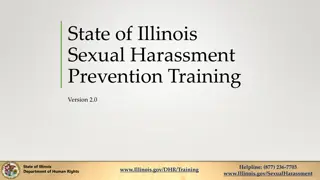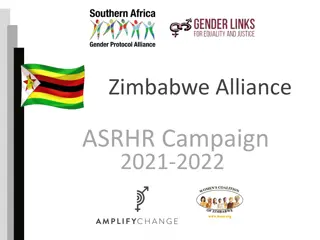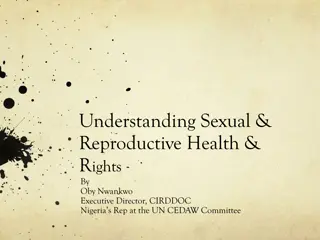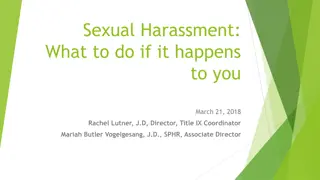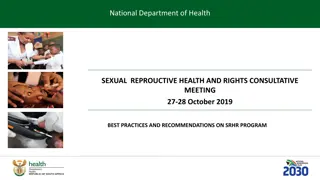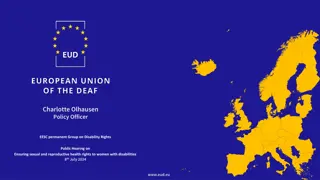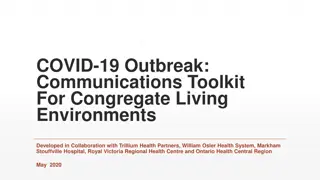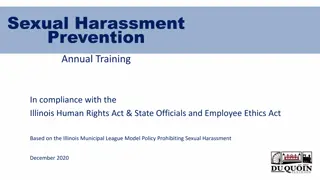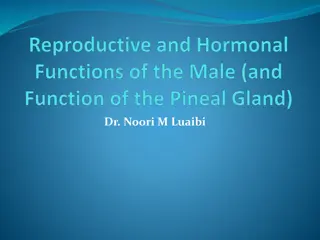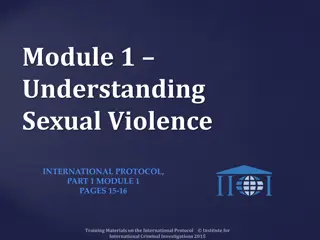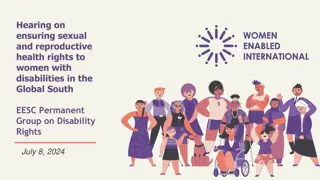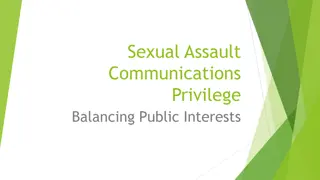Sexual and Reproductive Health and Rights Strategic Communications Toolkit Overview
The Sexual and Reproductive Health and Rights Strategic Communications Toolkit provides key information for developing advocacy and communication plans in the context of gender justice issues such as menstrual health, comprehensive sexual education, safe abortion, and more. It highlights important dates for action, themes, calls to action, and examples of SRHR messages. The toolkit aims to support efforts in advancing SRHR concerns in the Southern African region.
Download Presentation

Please find below an Image/Link to download the presentation.
The content on the website is provided AS IS for your information and personal use only. It may not be sold, licensed, or shared on other websites without obtaining consent from the author. Download presentation by click this link. If you encounter any issues during the download, it is possible that the publisher has removed the file from their server.
E N D
Presentation Transcript
Sexual and Reproductive Health and Rights Strategic communications toolkit
Overview HASHTAGS #SADCGenderBarometer10 #SADCGenderprotocol #VoiceandChoice #SheDecidesSADC #Mybodymychoice #RightbyHer #OurGirlsMatter #SDG2018 HANDLES HANDLES @GenderLinks @GenderProtocol @SAfAIDS The 2018 SADC Gender Protocol Barometer put a spotlight on the inter-linked gender justice issues of our time including menstrual health, comprehensive sexual education, maternal health, teenage pregnancies, safe abortion, GBV, HIV and Aids, Harmful practices and sexual diversity. In 2018 the Southern African Gender Protocol Alliance is stretching its Sexual and Reproductive Health and Rights Campaign from 28 September (International Safe Abortion Day) to the Sixteen Days of Activism that runs from 25 November, International Day of No Violence Against Women, to 10 December, Human Rights Day. The SRHR campaign will continue beyond December using key dates to advocate for key SRHR concerns in each country.
About the toolkit HASHTAGS #SADCGenderBarometer10 #SADCGenderprotocol #VoiceandChoice #SheDecides #Childnotbride #RightbyHer #OurGirlsMatter #DayoftheGirlChild #SDG2018 @GenderLinks @GenderProtocol @SAfAIDS The SRHR Strategic Communications toolkit will assist with key information to develop a SRHR advocacy and communication plan. For reference there are links to the relevant chapters in the 2018 SADC Gender Barometer: Constitutional and legal rights Education and training Gender based violence Sexual and productive health and rights HIV and AIDS In the toolkit, you will find information on: Key dates for action Themes and calls to action Examples of SRHR messages and slogans Developing community dramas
Key dates for action September to October 21 September 28 September 2 October 10 October International Day of Peace International Day of Safe Abortion International Day of Non Violence World Mental Health Day 11 October 16 October 17 October International Day of the Girl Child World Food Day International Day for the Eradication of Poverty
Key dates for action November to December 1 December 19 November 25 November 20 November International Day for the Elimination of Violence against Women World AIDS Day World Toilet Day Universal Children s Day 12 December 3 December 10 December International Universal Health Coverage Day International Day of Persons with Disabilities Human Rights Day
Key dates for action January to March 4 February 6 February 20 February World Cancer Day International Day of Zero Tolerance to Female Genital Mutilation World Day of Social Justice 1 March 8 March 22 March Zero Discrimination Day International Women s Day World Water Day
Key dates for action April to August 7 April 23 May 4 June 19 June International Day for the Elimination of Sexual Violence in Conflict International Day to End Obstetric Fistula International Day of Innocent Children Victims of Aggression World Health Day 30 July 12 August 17 August World Day against Trafficking in Persons International Youth Day SADC Day
Menstrual health HASHTAGS #SADCGenderBarometer10 #VoiceandChoice #SheDecidesSADC #MenstruationMatters # period #menstruation #OurGirlsMatter #NoMoreLimits #SDG2018 HANDLES HANDLES @GenderLinks @GenderProtocol @SAfAIDS @AmilfyChange There has been recent interest in supporting girls to ensure participation in education, with several projects providing disposable or re-usable sanitary napkins and collaborating with schools to ensure they have adequate sanitation facilities. Botswana is the only country in SADC that has a Menstrual Health Policy that requires schools to provide free sanitary pads. Seychelles and Mauritius are clearly far ahead of the rest of SADC. Ten SADC countries do not have even 50% coverage of basic services nationally and, though urban coverage is much better, seven countries do not have 50% coverage of basic sanitation in urban areas. Water provisionis a critical issue for women s health and wellbeing. Calls to action Adopt menstrual health policies to facilitate the provision of free or affordable sanitary pads. Invest in programmes to bring safe drinking water and sanitation services to all, including rural and urban communities in all parts of the region.
Maternal health HASHTAGS #Voice&Choice #SADCGenderBarometer10 #SheDecidesSADC #Childnotbride #RightbyHer #OurGirlsMatter #DayoftheGirlChild #SDG2018 @GenderLinks @GenderProtocol @SAfAIDS Maternal mortality represents one of the sharpest indicators of inequality. Thus, while maternal mortality in the developed world stands at only 12 per The maternal mortality rate in SADC varied from a high of 693 per 100 000 live births in DRC to a low of zero in Seychelles. Countries also have internal inequalities between younger and older women, rural and urban, poorer and wealthier. Achieving the SADC Protocol goal of eliminating maternal mortality will require commitment from families, local authorities, national governments and development partners. Call to action Most maternal mortality is preventable with access to good prenatal, delivery and post-natal care. This includes at least four ANC visits, with the first in the first trimester of pregnancy; deliveries in health facilities, attended by skilled health personnel; special support for younger and older mothers; adequate spacing between pregnancies; safe abortion and post-abortion services; and prevention and management of malaria and HIV and AIDS.
Sexual education and services HASHTAGS #VoiceandChoice #SADCGenderBarometer10 #SheDecidesSADC #SexualityEducation #WhySexualityEducation! #HealthRights4Youth #YouthSRHNOW HANDLES HANDLES @AfrYPoD @GenderLinks @GenderProtocol @SAfAIDS Leaders in SADC must address the differentials in access to all sexual and reproductive health services and maternal health services between rural and urban and across wealth quintiles to achieve the goals of the SADC Protocol. Considerable effort is being invested in HIV prevention including Comprehensive Sexuality Education (CSE), Voluntary Medical Male Circumcision (VMMC), services for key populations such as harm reduction, condoms, Pre-Exposure Prophylaxis (PrEP) and continued Prevention of Mother-to-Child Transmission (PMTCT). South Africa is set to become the first country in Southern Africa to decriminalise sex work. Call to action Provide and promote evidence-based, human-rights based, quality, socio- culturally sensitive and dignified care, especially to women and new- borns. Improve the quality of services for all, including training and motivation of health care providers. Improve provision of SRHR services for adolescents, including information, menstrual health and access to contraceptives.
Teenage pregnancies HASHTAGS #VoiceandChoice #Girlchild #MyBodyMyChoice #Voice&Choice #SheDecidesSADC #Childnotbride #RightbyHer #OurGirlsMatter #DayoftheGirlChild #IDG2018 #11Daysofaction HANDLES HANDLES @GirlsNotBrides @GenderLinks @GenderProtocol @SAfAIDS Teenage pregnancies prevent young girls from attending secondary school. In seven SADC countries (Angola, Mozambique, Malawi, DRC, Tanzania, Madagascar, Zimbabwe) more than 10% of every 1000 girls between the age of 15 and 19 have given birth. While a little lower, the rates of teenagers giving birth in Lesotho, Zambia and Namibia are between 7.6 and 9.3% per 1000 girls between ages 15 and 19. Mauritius and Botswana have the lowest rates of teenage pregnancies. Though SADC has seen some progress in reducing child marriage (e.g. Malawi and Zambia), teenage pregnancy remains an issue in several countries in the region. Calls to action Ensure that adolescents have access to comprehensive sexual education and contraception. Provide economic support to teenage mothers to facilitate their re-entry into schooling.
Safe abortion HASHTAGS/HANDLES #MyBodyMyChoice #VoiceandChoice #SheDecidesSADC #RightbyHer #Savelivesdon tmoralise #ReproductiveJustice #AbortionIsLegalinSA #NormaliseAbortion #SafeAbortionsSavesLives #OurBodiesOurFight #Sept28 #SDG2018 @GenderLinks @GenderProtocol @SAfAIDS In 2006, the African Policy Framework on Sexual and Reproductive Health and Rights recommended that policymakers needed to consider the issue of unsafe abortion in a dispassionate way. They called on them to view it as a public health issue because it results in elevated levels of morbidity and mortality in women, and particularly young women. However, in most SADC countries, the legislative environment remains unsupportive of safe abortion. South Africa and Mozambique offer legal abortion without qualification. Click here to read the Gender Links and SAFAIDS Abortion fact sheet. Calls to action Increasing accessibility and availability of contraception to all to reduce the need for termination of pregnancy. Reviewing legislation and provision of services to make safe abortions more readily available.
HIV and AIDS HASHTAGS/HANDLES #VoiceandChoice #SADCGenderBarometer10 #SheDecidesSADC #worldaidsday #TellSomeone #PrEP #knowyourstatus #EndAIDS #TreatmentForAll #SDG2018 @GenderLinks @GenderProtocol @SAfAIDS SADC is still the epicentre of the HIV epidemic, accounting for 38% of new infections globally in 2017. South Africa accounts for 39% of new infections in SADC, Mozambique 15% and Tanzania 10%. Though rates of new infections are declining, at the current rate of decline the region will still have at least 570, 000 new infections annually in 2020, more than double the target of 230,000. Young women 15 to 24 years old are only 10% of the total population but 26% of new HIV infections. Call to action Focus of prevention, including prevention of gender based violence and access to services for the most marginalised. Currently only 20% of global funding for HIV is being focused on prevention. Focus on adolescents and young people, one of the best vaccines for young people is to make sure that they are in schools which are safe, supportive and where they are learning skills that they can use in life. The epidemic in young girls and women must be tackled with specific approaches tailored to this age group and must also include boys and young men.
Gender based violence HASHTAGS/HANDLES #VoiceandChoice #SADCGenderBarometer10 #SheDecidesSADC #16daysofactivism #endvaw #orangetheworld #HearMeToo #metoo #GBV #SDG2018 @GenderLinks @GenderProtocol @SAfAIDS SADC is working towards a regional approach to meet the goal of eliminating gender-based violence by 2030. Despite the fact that 12 out of the 15 countries now have domestic violence legislation and 13 have sexual assault legislation, criminal justice system responses to GBV remain weak throughout the region. Fourteen countries now have legislation on sexual harassment. All countries have laws on human trafficking, but many lack the data to track victims. All countries offer some form of services to survivors of GBV, however under- resourced NGOs continue to do most of the work. All countries offer comprehensive treatment, including PEP, to survivors of violence. Calls to action Preventionneeds to sit at the centre rather end of the continuum for ending GBV. Many countries provide services to survivors and perpetrators of GBV, services are of low quality, better support services are needed. Addressing the different forms GBV requires strengthening the multi- sectoral approach. than at the
Child marriages HASHTAGS/HANDLES #VoiceandChoice #Girlchild #MyBodyMyChoice #Voice&Choice #SheDecidesSADC #Childnotbride #RightbyHer #OurGirlsMatter #DayoftheGirlChild #IDG2018 #withMalala #11Daysofaction @GirlsNotBrides @GenderLinks @GenderProtocol @SAfAIDS While all SADC countries subscribe to a minimum age for marriage for girls and boys there are often exceptions to the law. SADC Parliamentarians adopted a model law to eradicate child marriages in June 2016. The law aims to address any inconsistencies and gaps in national laws. The law stipulates that girls and boys can only marry after they are 18 years old. SADC member states need to explicitly outlaw child marriages and align their national laws and policies to the SADC Model Law to Eradicate Child Marriages. Click here to read the Girl Child fact sheet. Call to action End child marriage, including legislation and mobilisation of families and local leaders.
Sexual Diversity HASHTAGS/HANDLES #VoiceandChoice #SADCGederBarometer10 #loveislove #lgbtinclusion #diversity #beyou #bornthisway #betrue #takepride #poweredbypride #lgbtsupporter HANDLES HANDLES @GenderLinks @GenderProtocol @SAfAIDS While all SADC countries subscribe to human rights and dignity only South Africa, Mozambique and homosexuality. Homophobia runs high in most SADC countries. South Africa is the only country in the world with a constitution that recognises sexual orientation and only African country in which gay marriages are legal. But lesbian women are frequently subjected to GBV. DRC have decriminalised Click here to read the GL Policy Brief on LGTIQA. Call to action Decriminalise homosexuality; recognise all forms of sexual orientation and gender identity.
SRHR messages With Her: A Skilled Girl Force Speak out, speak up! Say no Unite to end gender violence! Girl not bride End gender violenc e now! HIV and AIDS prevention, treatment, care and support for all Every voice counts!
Community dramas HASHTAGS #SADCGenderBarometer10 #SADCGenderprotocol #VoiceandChoice #SheDecides #Childnotbride #RightbyHer #OurGirlsMatter #DayoftheGirlChild #SDG2018 @GenderLinks @GenderProtocol @SAfAIDS Community drama is an excellent way to engage with issues in an accessible way. The steps involved are: Decide on a theme What are the different issues that will be covered? What is the storyline/story you want to tell? Develop a script. Decide on who will take which rolls? Perform the drama, record it on your cell phone. Play it back. Make any changes needed on your script. Examples of SRHR videos on YouTube: https://www.youtube.com/watch?v=H0pexVorDoQ- SRHR and ICTs https://www.youtube.com/watch?v=ArVlUcEFYd4 - Condom use https://www.youtube.com/watch?v=RzedtHKwp_s - STIs





